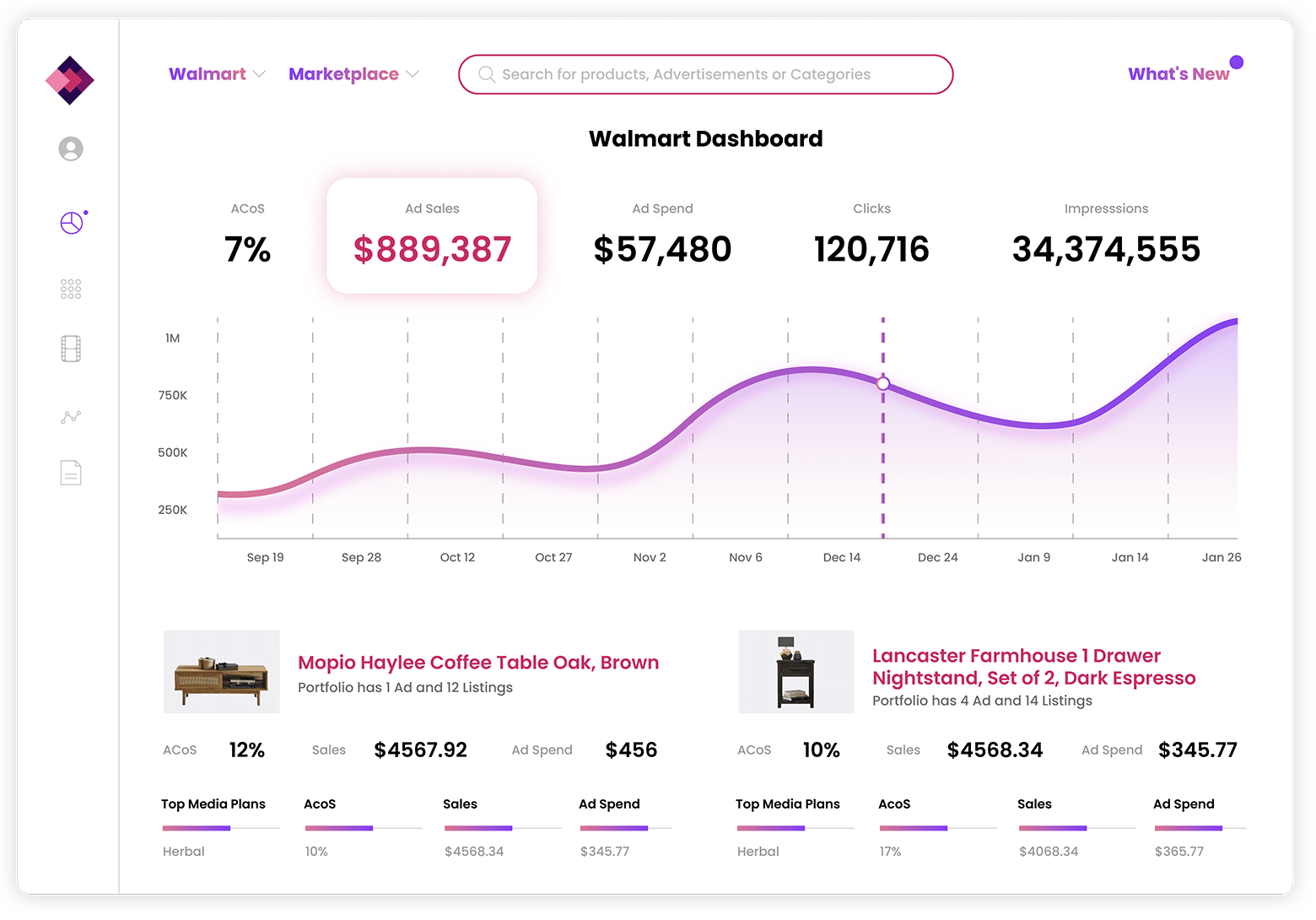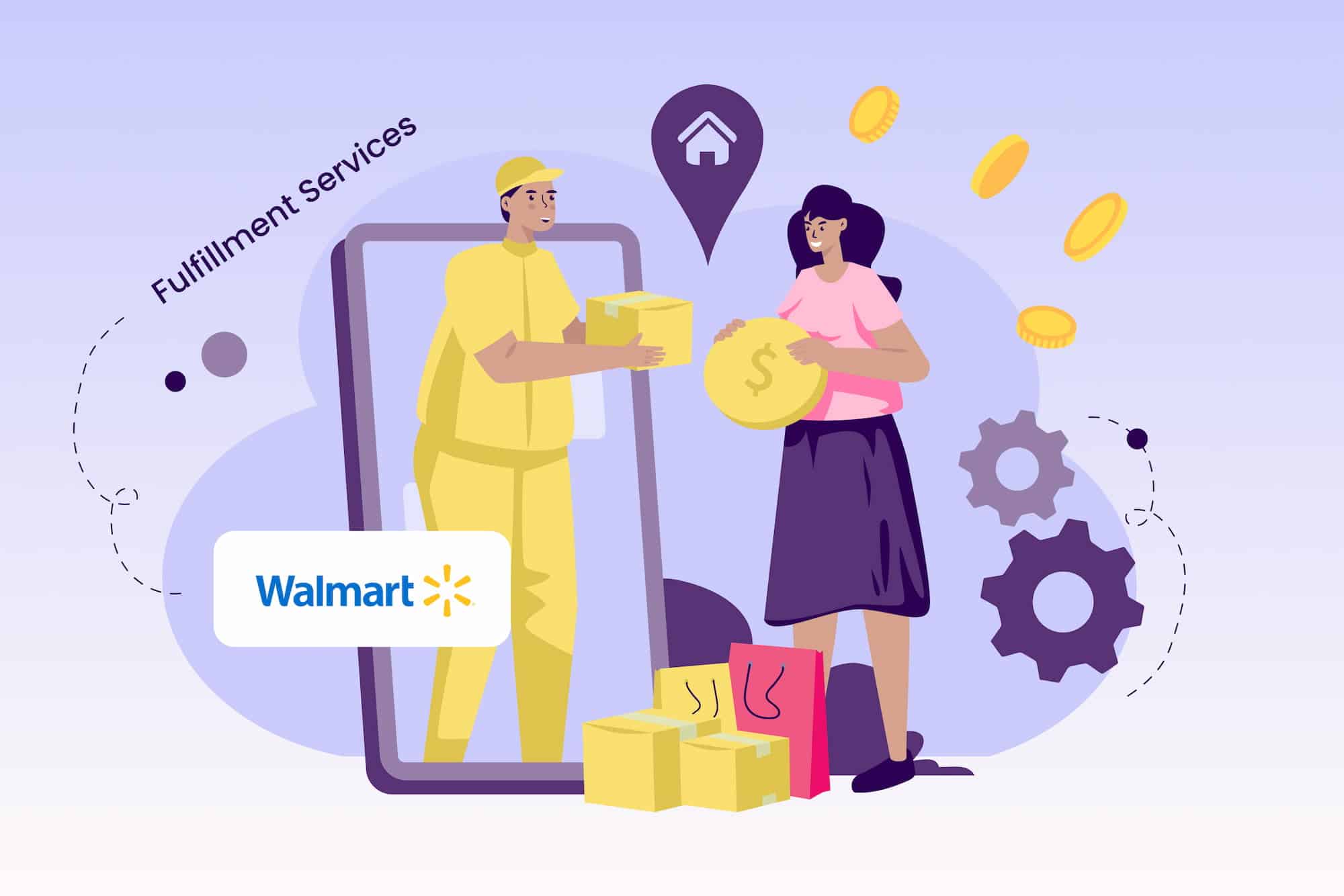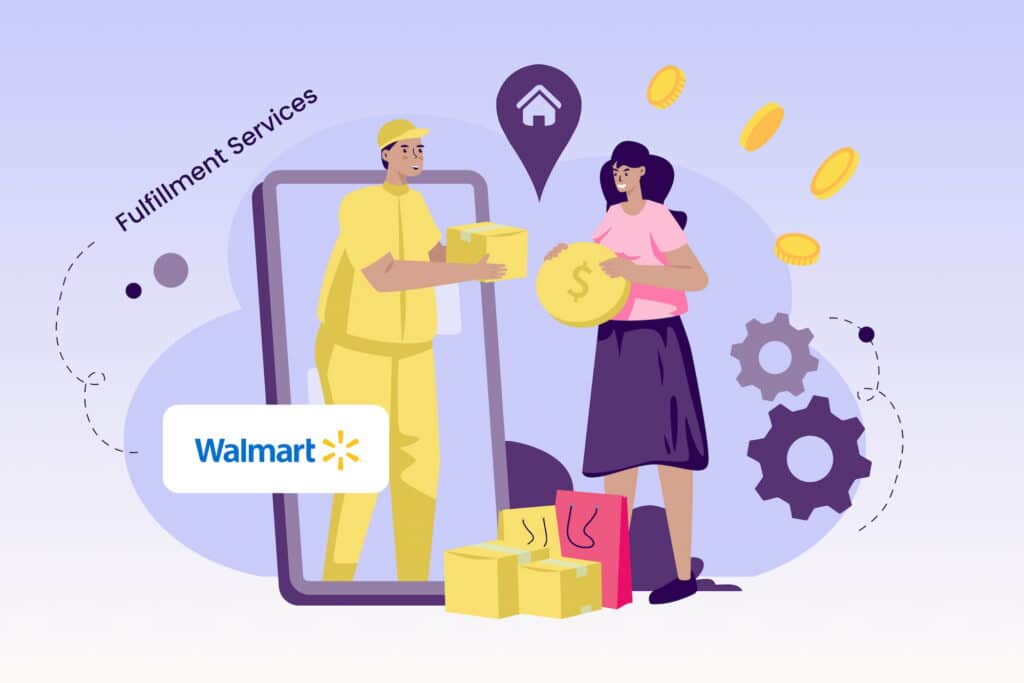For many sellers, especially those new to marketplace selling, fulfillment can be one of the steepest hurdles. Storing, managing, preparing, and shipping inventory is not a small task, particularly if your resources are already at capacity or you don’t have a warehousing option in place to meet demands.
To provide competitive service for sellers and buyers, Walmart Marketplace offers its fulfillment solution, Walmart Fulfillment Services (WFS). For brands that need assistance or simply don’t want to deal with the complexities, WFS can be a great choice. However, it’s not for everyone. Before taking the plunge, read on to learn more about the pros and cons of this fulfillment option.
Looking to understand how Walmart Fulfillment Services can impact your business? At Trellis, we’ve helped brands unlock growth on Walmart with smart pricing, advertising automation, and insights that go beyond fulfillment—so you can see how WFS fits into a bigger strategy.
Key Takeaways
- Marketplace sales on Walmart can be fulfilled by merchants or managed directly by Walmart via the WFS program.
- WFS participants ship inventory to Walmart’s warehouses; storing, packaging, and shipping to customers are managed by Walmart’s resources.
- While there are many advantages to utilizing WFS as a marketplace seller, like branded packaging, two-day shipping, increased chance of Buy Box wins, and customer service support, WFS won’t be the best fit for all businesses.
Walmart Fulfillment Services (WFS) is Walmart’s version of Fulfillment by Amazon (FBA). It costs about $3 – $12 per unit, requires a Pro Seller account ($50 per month), and grants access to Walmart’s 2-Day Delivery badge, which can raise Buy Box odds by 40 percent. WFS handles storage, shipping, and returns so sellers can focus on growth.
Boost Your Ad Performance: Use this PPC Tool — WFS products with the Free Shipping badge see up to 40 percent higher ROAS during campaigns.
What Are Walmart Fulfillment Services?
Walmart Fulfillment Services (WFS) provides third-party sellers on the Walmart Marketplace with a complete logistics solution, handling inventory storage, order fulfillment (picking, packing, and shipping), and customer support, including returns.
And how do Walmart Fulfillment Services work? WFS is a way to outsource fulfillment, letting Walmart handle the responsibility of packing and shipping Walmart products to buyers. However, getting started takes more coordination than is true of other platform-based fulfillment services, like Amazon. In order to take part in this program, sellers need to apply and be approved.
Once accepted, sellers can start converting items to “Walmart Fulfilled.” Once products have been appropriately designated, they can then be shipped to Walmart warehouses. Walmart will then assign SKUs to manage inventory and distribution and take care of the remaining processes needed to get your items in customers’ hands.
Read more: 6 Walmart Advertising Strategies for Full-Funnel Results
WFS sellers achieve 40 percent higher Buy Box share and 2.3× faster sales velocity compared to self-fulfilled sellers.
Walmart Fulfillment Services Pros
There’s a lot to like about Walmart Fulfillment Services. These are some pros to keep in mind when considering it:
Fast Shipping
It’s possible to offer fast shipping on your own, but letting Walmart handle this process can cut out the expenses of one- or two-day service through couriers like FedEx—and reduce time spent dropping off packages. Walmart generally offers customers two-day delivery, like Amazon Prime, ensuring there’s never a delay.
Increase Search Visibility
Walmart’s algorithm prioritizes a few things when determining rankings in search results, and fulfillment speed is on the list. When you enroll in WFS, your products will get tagged with “Two Day Delivery,” which automatically improves general visibility and the likelihood of Buy Box wins.
Customer Service is Handled
Since your business isn’t handling fulfillment, you need to worry a bit less about handling customer service issues. If customers need replacements, returns, or refunds, the WFS customer service team will be the primary point of contact for shoppers.
More Trust with Customers
Walmart is a trusted brand name for millions of people, with over 4,500 stores from coast to coast. When WFS handles fulfillment, products will be delivered in Walmart packaging, providing an extra layer of legitimacy to your products. Many customers don’t know they’re ordering from marketplace sellers rather than Walmart directly, and looking the part can boost your business. This can help with getting more Walmart reviews, too.
Reporting is Clear
WFS reporting tools are easy to use and make things like inventory management a breeze. Because Walmart is doing the heavy lifting, its internal dashboards can offer more resources than most sellers can accomplish individually.
Pricing is Straightforward
Walmart Fulfillment Services aren’t free to use, but the pricing structure is very straightforward. Prices are based on the weight of inventory and storage space needed so sellers can determine costs up-front. There are no hidden fees or extra expenses; what you see is what you get with WFS.
Great Seller Support
Walmart does an excellent job supporting those who are enrolled in WFS. All questions are managed by a dedicated support team, so Walmart sellers can easily stay informed on new fulfillment developments and up-to-date with current policies.
Easy Returns
Processing returns can be a surprisingly complex part of eCommerce sales. With WFS, you can remove potential headaches thanks to a straightforward returns policy. Walmart will process any returned inventory and issue refunds on your behalf.
Boosted Conversion with TwoDay Tags
When you use WFS, your products become eligible for Walmart’s fast-shipping badges, like TwoDay Delivery. These tags not only increase buyer trust but also push your listings higher in search results. Walmart reports that sellers who qualify for fast shipping often see a measurable lift in sales and better Buy Box performance.

Walmart Fulfillment Services Cons
While Walmart Fulfillment Services have many upsides, it won’t be the right option for all sellers. These cons may hold your business back:
Location Limitations
WFS isn’t available everywhere; shipping is limited to the U.S. and its associated territories. For sellers who want to operate outside these locations, WFS can make it a challenge to branch out into new markets.
Single Channel Fulfillment
For sellers who prefer a multi-channel approach to sales, using WFS can be a challenge. Sellers enrolled in this program can’t sell inventory managed through any other platform—a distinct difference from Fulfillment by Amazon—which can limit opportunities for those who prefer a more diversified strategy.
Strict Rules to Follow
Since there’s an approval process associated with joining WFS, sellers must follow plenty of strict rules. These include what kinds of products can be accepted and adherence to single-channel fulfillment policies. Breaking these restrictions can result in an entire seller account being shut down.
Product Requirements
WFS might not be possible for sellers with large or heavy products or items in certain niches. The program requires products weighing 500 pounds or less and will not fulfill perishable or highly regulated items requiring temperature control.
Hidden Fees
While Walmart publishes straightforward fulfillment and storage rates, many sellers overlook additional charges. Costs like product returns, inventory removals or disposals, peak-season storage surcharges, hazmat handling, and special projects can quickly add up. These expenses may not appear in basic fee tables but still affect your margins if you don’t plan for them.
Increase Sales on Walmart By 12x
Our automated Walmart PPC platform is everything you need to take your advertising profits to the next level.

Can Anyone Use Walmart Fulfillment Services?
Unlike Amazon’s fulfillment platform, Walmart’s structure is slightly more restrictive. WFS isn’t open to everyone; sellers must apply for the program and be accepted through an internal review process. You’ll need to be able to demonstrate the ability to take sales seriously before being allowed to enroll.
Requirements for Walmart Fulfillment Services
To be accepted into the Walmart Fulfillment Services program, sellers will need to meet some basic criteria:
- First, sellers must create a Walmart Marketplace account and complete an application to answer questions about merchandise and related services. As mentioned previously, not all products are permitted under WFS. If your inventory doesn’t qualify, your application will be rejected.
- Once an application is complete, the WFS team will review it. While specific factors aren’t outlined, some details considered include sales history on Walmart.com, a record of on-time deliveries, and excellent customer service.
Keep in mind that acceptance into the program takes time, so ensure you check your application status throughout the review period.
Read more: 11 Walmart SEO Strategies For Sellers
Application & Onboarding Process
Getting started with Walmart Fulfillment Services (WFS) is straightforward, but Walmart requires detailed information before approving your account. You’ll submit your application through Seller Center, where Walmart asks for:
- Business details like legal name, tax ID, and U.S. business address.
- Product catalog information, including SKU counts, categories, and UPC/GTIN/EAN codes.
- Brand authorization if you sell branded products.
- Product specs such as weight and dimensions, so Walmart can confirm eligibility.
- Sales volume estimates or historical revenue data.
Once approved, you’ll receive instructions for shipping inventory to one of Walmart’s fulfillment centers. Onboarding includes creating a WFS Shipping Plan, preparing inventory according to packaging guidelines, and scheduling freight. Walmart then handles receiving, storage, and making your products available with fast-shipping tags like TwoDay.
Is Walmart WFS Good for Beginners?
This program can be helpful for those starting out in the eCommerce space, especially since fulfillment is its own unique obstacle to becoming a successful seller. However, to be accepted into the program, sellers must prove their product’s quality, including their ability to fulfill orders. This means in the early days of sales, you’ll have to ensure fulfillment is managed well internally.
The Impact of Strong Fulfillment for Businesses
To a buyer, fulfillment is a big part of the decision-making process, particularly after Amazon’s market shake-up with the launch of Prime and two-day shipping. Customers are used to getting their products quickly and delivered in a timely manner. Lagging shipping speeds, unprofessional packaging, and the potential for damaged items can be hugely disruptive to buyers, particularly if other, more appealing options are available. By being able to promise a smooth experience, buyers are more likely to trust you—and to shop with you again.
Read More: Amazon Peak Season: Key Dates for Sellers in 2025
Increase RoAS on Walmart By 75%
Our automated Walmart PPC platform is everything you need to take your advertising profits to the next level.

Walmart Fulfillment Services Fees
Sellers using WFS pay for the warehouse storage space, picking and packing process, and shipping costs. However, the WFS fee model tends to be more straightforward than some competitor platforms. Fees fall into a few key categories:
- Fulfillment Fees: These are based on a product’s shipping or dimensional weight. For example, products under one pound carry a fee of $3.45–$4.95 per unit. Above this weight, fees increase in brackets based on size and weight, while oversized items (generally over 150 pounds) are priced individually.
- Storage Fees: Storage is billed monthly per cubic foot. Standard rates are $0.75 per cubic foot from January through September and $1.50 per cubic foot during peak season (October through December). Inventory stored for extended periods during peak months may incur additional surcharges.
- Additional Fees: Sellers may choose extra services such as Walmart Prep Services for labeling and bagging, charged per item. Other potential costs include returns processing (around $3.00 per unit), removal or disposal fees ($0.50–$0.60 per unit), hazmat handling, and special projects like reboxing or relabeling.
Keep in mind that WFS fees are on top of Walmart’s standard referral fees, which generally range between 6% and 15%.
Walmart Fulfillment Services vs. Amazon FBA
In many ways, Walmart Fulfillment Services and Fulfillment by Amazon are similar. Under both programs, the marketplace staff handles the fulfillment process, including storage, packing, and shipping. However, there are some notable differences:
- Marketplace Reach: FBA offers services worldwide, while Walmart WFS is limited to the U.S.
- Fees: WFS has a straightforward fee structure, while FBA is a little less transparent and requires a monthly subscription cost.
- Product Categories: FBA is far less strict about eligible products.
- Warehousing Options: FBA has nearly 200 global warehouses, with over 100 in the U.S. alone, while WFS is limited to just over 30.
- Sales Channels: FBA offers an omnichannel approach to selling, while WFS only supports single-channel opportunities.
- Returns Options: FBA only permits returns via mail, while WFS allows customers to make returns in-store.
- Sales Growth Opportunities: WFS customers generally see an accelerated growth rate year over year.
In many ways, Amazon provides a more expansive array of options under FBA, which is to be expected; FBA has been in place longer than WFS. However, with more growth potential as Walmart’s marketplace is newer and less saturated, there’s much to be said for selling and advertising on Walmart via WFS.
Is WFS Right for My Business?
Walmart Fulfillment Services may be right for you if:
- You’re newer to eCommerce and don’t have a fulfillment infrastructure like warehousing or shipping support.
- You’d prefer to use your time on other elements of seller management.
- You’re scaling your business and want the process of accelerated sales managed for you.
- You’re an individual seller or small operation without the bandwidth to take on fulfillment.
- You’re not interested in managing things like returns and refunds.
- You’d like increased visibility on the Walmart marketplace, and a higher likelihood of Buy Box wins.
- You favor the legitimacy of Walmart-branded packaging.
- You need assistance with customer service.
- You want to ensure your customer’s fulfillment experience runs smoothly and efficiently.
Conversely, Walmart FBA might not be the ideal choice if:
- You can handle fulfillment in-house for a cheaper rate or have an infrastructure built out already.
- Your products aren’t all eligible to be accepted into the program.
- You want to sell to a broader market than the WFS U.S.-specific footprint.
- You already have effective inventory management methods compared to Walmart Connect’s reporting tools.
- You don’t have enough products listed for sale—Walmart recommends at least 50, though there’s no minimum—to make the program worthwhile.
- Selling isn’t a full-time operation, or sales volume doesn’t require third-party support.
Increase RoAS on Walmart By 75%
Our automated Walmart PPC platform is everything you need to take your advertising profits to the next level.

How Can Trellis Help With Walmart Fulfillment Services?
Walmart Fulfillment Services (WFS) can simplify logistics, but success depends on more than storage and shipping. That’s where Trellis comes in. Our platform combines AI-powered advertising, dynamic pricing, and full-funnel analytics to help you maximize the value of WFS.
Here’s how Trellis supports your Walmart growth:
- Advertising Automation: Get your WFS-eligible products in front of more shoppers with automated campaign management for Walmart Connect. Trellis optimizes bids, keywords, and budgets to improve visibility and sales.
- Dynamic Pricing: Winning the Walmart Buy Box requires competitive pricing. Trellis uses real-time market data to adjust prices automatically, keeping you profitable while improving your chances of Buy Box placement.
- Content Optimization: Pairing WFS with strong listings drives even better results. Trellis helps optimize product content with SEO-driven keywords that boost both paid and organic visibility.
- Promotion Planning: WFS makes fast shipping easy, and Trellis ensures your coupons and promotions work strategically—driving traffic without hurting your margins.
- Analytics & Insights: With Trellis, you’ll see how fulfillment impacts performance across your catalog. Our dashboards connect fulfillment data with ad spend, sales velocity, and customer behavior to guide smarter decisions.
Trellis helps you unlock the full potential of Walmart Fulfillment Services by aligning logistics with smarter advertising, pricing, and analytics. Together, WFS and Trellis create a structure for growth that’s scalable and profitable. Book a demo with Trellis today to see how smarter automation, pricing, and insights can maximize your WFS results.
Final Thoughts
When it comes to enrolling in Walmart Fulfillment Services, make the best choice for your business needs, including what you can afford and the level of service required. For many sellers, it makes sense to have fulfillment handled by Walmart so you can focus on the core operations of your business as you seek to get a leg up on the competition. Trellis can help you do just that by using AI and automation to improve your product listings, strengthen PPC advertising, and drive conversions. To find out more, reach out to us today.
Want more ways to grow your eCommerce business? Subscribe to The Climb: Trellis’ monthly newsletter with quick updates, expert insights, and practical tips to help your brand reach new heights.






